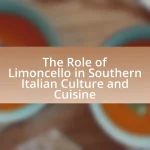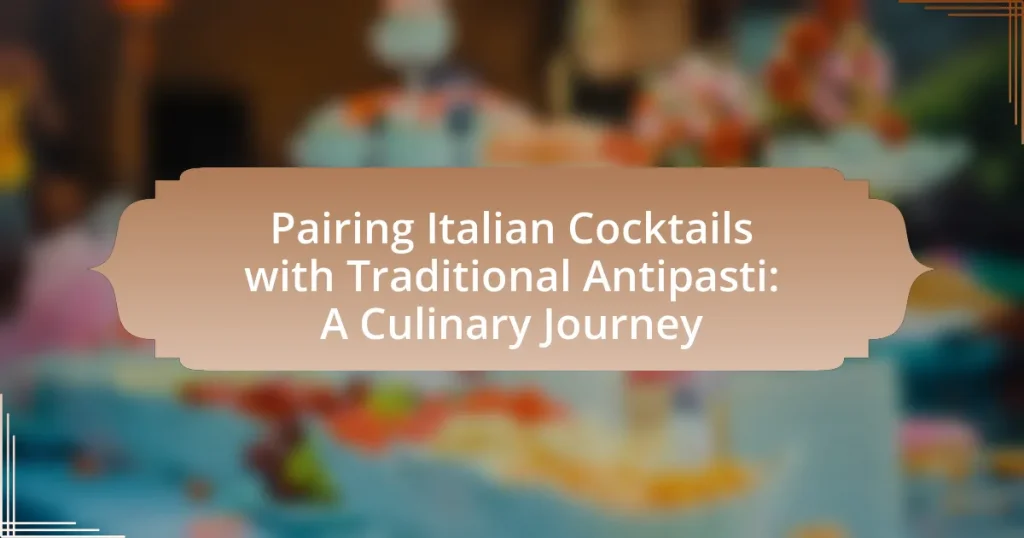The article focuses on the pairing of Italian cocktails with traditional antipasti, highlighting the significance of these combinations in Italian dining culture. It explores the characteristics of Italian cocktails, such as their use of regional ingredients and traditional preparation methods, alongside the diverse offerings of antipasti, which include cured meats, cheeses, and marinated vegetables. Key pairings are discussed, emphasizing how specific cocktails enhance the flavors of various antipasti, while also considering factors like flavor compatibility, texture contrast, and seasonal ingredients. The article provides insights into creating memorable pairing experiences and offers resources for further exploration of Italian culinary traditions.

What are Italian Cocktails and Traditional Antipasti?
Italian cocktails are beverages that typically feature ingredients such as vermouth, amaro, and various spirits, often served as aperitifs to stimulate the appetite. Traditional antipasti are a variety of appetizers that include cured meats, cheeses, olives, and marinated vegetables, served before the main meal. The combination of Italian cocktails and traditional antipasti is rooted in Italian dining culture, where cocktails like Negroni or Spritz complement the flavors of antipasti, enhancing the overall culinary experience.
How do Italian Cocktails differ from other cocktails?
Italian cocktails differ from other cocktails primarily in their use of regional ingredients and traditional preparation methods. Italian cocktails often incorporate local spirits such as Aperol, Campari, and vermouth, which are integral to classic drinks like the Negroni and Spritz. Additionally, Italian cocktails emphasize balance and simplicity, focusing on fresh flavors and high-quality components, reflecting Italy’s culinary heritage. This approach contrasts with many other cocktail cultures that may prioritize complexity or elaborate presentations. The historical significance of these cocktails is evident in their origins, with many recipes dating back to the 19th century, showcasing Italy’s long-standing tradition of aperitivo culture, which encourages socializing and enjoying food alongside drinks.
What are the key ingredients in popular Italian Cocktails?
The key ingredients in popular Italian cocktails include Campari, vermouth, Prosecco, and limoncello. Campari is essential for cocktails like the Negroni, which combines equal parts Campari, gin, and sweet vermouth. Vermouth is a key component in the classic Americano, made with Campari, sweet vermouth, and soda water. Prosecco is often used in the Spritz, which mixes Prosecco with Aperol and soda water. Limoncello serves as a refreshing base for cocktails like the Limoncello Spritz, combining limoncello with Prosecco and soda. These ingredients reflect the traditional flavors and styles of Italian mixology.
How do the preparation methods of Italian Cocktails vary?
The preparation methods of Italian cocktails vary primarily in their mixing techniques, ingredient combinations, and serving styles. For instance, classic cocktails like the Negroni are built by stirring equal parts gin, vermouth, and Campari over ice, while others like the Bellini require blending fresh peach puree with Prosecco. Additionally, some cocktails, such as the Spritz, are prepared by combining wine, soda, and bitters, emphasizing a refreshing and effervescent profile. These variations reflect regional preferences and seasonal ingredients, showcasing Italy’s diverse culinary landscape.
What defines Traditional Antipasti in Italian cuisine?
Traditional antipasti in Italian cuisine are defined as a variety of appetizers served before the main meal, typically featuring a selection of cured meats, cheeses, olives, marinated vegetables, and bread. These dishes are designed to stimulate the appetite and showcase regional ingredients, reflecting Italy’s diverse culinary heritage. The historical significance of antipasti dates back to the Roman era, where small bites were served to accompany wine, establishing a tradition that emphasizes communal dining and the enjoyment of flavors.
What are the common ingredients found in Antipasti?
Common ingredients found in antipasti include cured meats, cheeses, olives, marinated vegetables, and bread. Cured meats such as prosciutto and salami provide savory flavors, while cheeses like mozzarella and pecorino add creaminess. Olives contribute a briny taste, and marinated vegetables, such as artichokes and peppers, offer tanginess. Bread, often served as a base or accompaniment, enhances the overall experience. These ingredients reflect traditional Italian culinary practices, emphasizing fresh, high-quality components that are essential to antipasti.
How is Antipasti traditionally served in Italy?
Antipasti is traditionally served in Italy as a selection of small dishes that precede the main meal, often arranged on a large platter or served individually. This assortment typically includes cured meats, cheeses, olives, marinated vegetables, and bread, allowing diners to sample a variety of flavors and textures. The practice of serving antipasti is rooted in Italian culinary tradition, emphasizing the importance of communal dining and the enjoyment of food as a social experience.
Why is pairing cocktails with Antipasti significant?
Pairing cocktails with Antipasti is significant because it enhances the overall dining experience by complementing the flavors and textures of the food. Cocktails, often crafted with fresh ingredients and balanced flavors, can elevate the taste of Antipasti, which typically includes a variety of cured meats, cheeses, and marinated vegetables. This pairing is rooted in Italian culinary tradition, where the right drink can accentuate the umami and acidity present in Antipasti, creating a harmonious balance. For example, a classic Negroni, with its bitter and sweet notes, pairs well with salty prosciutto, enhancing the savory profile of the dish.
What are the flavor profiles of Italian Cocktails and Antipasti?
Italian cocktails typically feature a balance of bitter, sweet, and herbal flavors, while antipasti showcase a variety of savory, tangy, and umami profiles. Classic Italian cocktails like Negroni and Aperol Spritz emphasize bitterness from ingredients such as Campari and Aperol, complemented by sweetness from vermouth or soda. Antipasti, which include items like cured meats, cheeses, olives, and marinated vegetables, often present a salty and tangy taste, enhanced by herbs like basil and oregano. The combination of these flavor profiles creates a harmonious pairing, where the bitterness of cocktails can cut through the richness of antipasti, while the savory elements of antipasti can enhance the aromatic qualities of the drinks.
How does pairing enhance the dining experience?
Pairing enhances the dining experience by creating complementary flavors that elevate both the food and drink. When Italian cocktails are paired with traditional antipasti, the unique ingredients and profiles of each enhance the overall taste, making the meal more enjoyable. For example, a bitter Negroni can balance the richness of cured meats, while a refreshing Spritz can cut through the creaminess of cheese. This synergy not only heightens the sensory experience but also encourages a deeper appreciation of the culinary traditions involved, as evidenced by studies showing that well-paired food and drink can significantly improve satisfaction and enjoyment during meals.

What are the Best Pairings of Italian Cocktails with Antipasti?
The best pairings of Italian cocktails with antipasti include Negroni with cured meats, Aperol Spritz with bruschetta, and Bellini with seafood antipasti. Negroni’s bitter and herbal notes complement the saltiness of cured meats like prosciutto and salami, enhancing the overall flavor experience. Aperol Spritz, with its refreshing citrus and herbal profile, pairs well with the freshness of bruschetta, balancing the acidity of tomatoes. Bellini, made with Prosecco and peach puree, is ideal for seafood antipasti, as its fruity sweetness contrasts beautifully with the brininess of seafood, creating a harmonious taste. These pairings are rooted in traditional Italian culinary practices, where the balance of flavors is essential for an enjoyable dining experience.
Which Italian Cocktails pair well with specific Antipasti?
Negroni pairs well with cured meats like prosciutto and salami, enhancing their savory flavors. The bitterness of Campari in the Negroni complements the saltiness of the meats, creating a balanced taste experience.
Aperol Spritz is an excellent match for light antipasti such as marinated olives and bruschetta. The refreshing citrus notes of Aperol cut through the richness of the olive oil and the acidity of the tomatoes, making it a harmonious pairing.
Bellini, made with Prosecco and peach puree, pairs beautifully with seafood antipasti like shrimp cocktail or smoked salmon. The fruity sweetness of the Bellini enhances the delicate flavors of the seafood, providing a refreshing contrast.
Lastly, a classic Spritz, typically made with Prosecco, Aperol, and soda water, goes well with vegetable antipasti such as grilled zucchini or roasted peppers. The effervescence and slight bitterness of the Spritz complement the earthy flavors of the vegetables, creating a delightful combination.
What are the ideal cocktails for meat-based Antipasti?
The ideal cocktails for meat-based Antipasti include Negroni, Aperol Spritz, and Campari Soda. Negroni, made with gin, vermouth, and Campari, complements the savory flavors of cured meats due to its bitter and herbal notes. Aperol Spritz, a mix of Aperol, prosecco, and soda water, offers a refreshing contrast that balances the richness of meats. Campari Soda, combining Campari with soda water, enhances the umami of meat-based dishes with its bitter profile. These cocktails are traditionally enjoyed in Italy and are well-suited for enhancing the flavors of meat-based Antipasti.
How do cocktails complement vegetarian Antipasti options?
Cocktails complement vegetarian Antipasti options by enhancing the flavors and textures of the dishes. The acidity and complexity of cocktails, such as a classic Negroni or a refreshing Spritz, can balance the richness of ingredients like olives, cheeses, and marinated vegetables. For instance, the bitterness of Campari in a Negroni contrasts beautifully with the saltiness of feta cheese, while the effervescence of a Spritz can lighten the palate after indulging in creamy dips. This synergy not only elevates the dining experience but also encourages a harmonious interplay between the drink and the food, making each bite and sip more enjoyable.
What factors should be considered when pairing?
When pairing Italian cocktails with traditional antipasti, consider flavor compatibility, texture contrast, and regional harmony. Flavor compatibility ensures that the cocktail’s taste complements the antipasti, such as pairing a bitter Negroni with salty prosciutto. Texture contrast enhances the dining experience; for instance, a creamy cocktail can balance crunchy antipasti. Regional harmony is crucial, as cocktails and antipasti from the same Italian region often share complementary flavors, like pairing a spritz from Veneto with local cheeses. These factors enhance the overall culinary experience by creating a balanced and enjoyable pairing.
How do seasonal ingredients influence pairing choices?
Seasonal ingredients significantly influence pairing choices by enhancing flavor compatibility and freshness in culinary experiences. For instance, using ripe tomatoes in summer antipasti pairs well with light, herbaceous cocktails like a basil-infused spritz, as both elements share vibrant, fresh characteristics. Research indicates that seasonal produce not only offers superior taste but also aligns with traditional culinary practices, as seen in Italian cuisine, where seasonal availability dictates ingredient selection. This alignment fosters a harmonious balance between cocktails and antipasti, ensuring that flavors complement rather than clash, ultimately elevating the dining experience.
What role does presentation play in pairing cocktails with Antipasti?
Presentation plays a crucial role in pairing cocktails with Antipasti by enhancing the overall dining experience and influencing the perception of flavor. A visually appealing cocktail can stimulate appetite and create anticipation, making the pairing more enjoyable. For instance, vibrant colors and artistic garnishes can complement the aesthetic of Antipasti, which often features a variety of textures and colors. Research indicates that visual presentation can significantly affect taste perception; a study published in the journal “Appetite” found that people rated food as more flavorful when it was presented attractively. Therefore, the thoughtful presentation of cocktails not only elevates the visual appeal but also enhances the sensory experience of enjoying Antipasti.

How can one create a memorable pairing experience?
To create a memorable pairing experience, one should focus on harmonizing flavors between Italian cocktails and traditional antipasti. This involves selecting cocktails that complement the ingredients and textures of the antipasti, such as pairing a Negroni with salty prosciutto or a Spritz with marinated olives. Research indicates that flavor pairing enhances the overall dining experience, as supported by studies in sensory science which show that complementary flavors can elevate taste perception. By thoughtfully considering the balance of flavors, one can craft an engaging and enjoyable culinary journey.
What tips can enhance the cocktail and Antipasti pairing experience?
To enhance the cocktail and Antipasti pairing experience, focus on balancing flavors and textures. Pair cocktails with Antipasti that complement or contrast each other; for example, a bitter Negroni can balance the richness of cured meats, while a refreshing Spritz can enhance the flavors of marinated vegetables. Additionally, consider the acidity and sweetness of cocktails, as these elements can elevate the taste of salty cheeses or olives. Research indicates that successful pairings often involve matching the intensity of flavors; thus, stronger cocktails should accompany more robust Antipasti selections.
How can one balance flavors between cocktails and Antipasti?
To balance flavors between cocktails and Antipasti, one should focus on complementary taste profiles. For instance, a bitter cocktail like an Aperol Spritz pairs well with salty Antipasti such as prosciutto or olives, as the bitterness enhances the savory notes. Additionally, using fresh herbs in cocktails can echo the herbal elements often found in Antipasti, creating a harmonious flavor experience. This approach is supported by culinary principles that emphasize the balance of contrasting flavors, such as sweet and salty or bitter and savory, which enhance the overall dining experience.
What are some common mistakes to avoid when pairing?
Common mistakes to avoid when pairing Italian cocktails with traditional antipasti include ignoring flavor compatibility, neglecting regional pairings, and overlooking the balance of acidity and richness. Flavor compatibility is crucial; for instance, a bitter cocktail may clash with a sweet antipasto. Neglecting regional pairings can lead to mismatched tastes, as certain cocktails and antipasti are designed to complement each other based on their origins. Additionally, overlooking the balance of acidity and richness can result in a dish or drink overpowering the other, diminishing the overall dining experience.
How can one experiment with new pairings?
One can experiment with new pairings by systematically combining different Italian cocktails with various traditional antipasti to discover complementary flavors. This approach involves selecting a cocktail, such as a Negroni, and pairing it with antipasti like marinated olives or bruschetta, then assessing the taste experience. Research indicates that flavor pairing can enhance the overall dining experience, as demonstrated in studies on food and beverage compatibility, which show that certain flavor profiles can either clash or harmonize, impacting enjoyment. By documenting these combinations and their outcomes, one can refine their pairing strategy over time.
What resources are available for exploring Italian cocktails and Antipasti?
Books, websites, and culinary classes are valuable resources for exploring Italian cocktails and Antipasti. Notable books include “The Italian Cocktail Book” by Marco Pierfrancesco, which provides recipes and historical context, and “Antipasti: The Ultimate Guide” by Carla Capalbo, offering insights into traditional antipasti dishes. Websites like Liquor.com and Eater feature articles and recipes focused on Italian cocktails and antipasti pairings. Additionally, culinary schools often offer classes that delve into Italian cuisine, including cocktail and antipasti preparation, enhancing practical knowledge and skills.
How can personal preferences shape pairing choices?
Personal preferences significantly influence pairing choices by guiding individuals toward flavors and textures they enjoy. For instance, someone who prefers bitter flavors may opt for a Negroni cocktail paired with a rich, savory antipasto like aged cheese or cured meats, enhancing their dining experience. Research indicates that taste preferences are shaped by cultural background and individual experiences, which further dictate pairing decisions. Therefore, understanding personal preferences allows for more tailored and satisfying combinations in culinary pairings.










